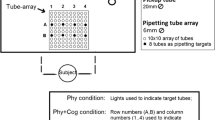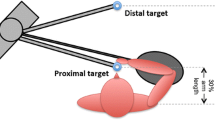Summary
The purpose of the study was to analyse the effect of arm-shoulder fatigue on manual performance. Ten experienced carpenters performed three standardized tasks (nailing, sawing and screwing). Electromyographic activity was recorded from six arm-shoulder muscles and the performances were video-filmed. After 45 min of standardized arm-cranking (arm-shoulder-fatiguing exercise of approximately 70%–80% maximal oxygen consumption), the tasks were repeated. The number of work movements and the time taken for each task were recorded and the quality of the work performed was compared. After the fatiguing exercise, only nailing was perceived as being harder and more mistakes were made during nailing and sawing. Movement performance was not influenced during nailing but was slightly slower during sawing and faster during screwing. However, there were increased mean EMG amplitudes in the upper trapezius and biceps muscles during nailing, in the upper trapezius, anterior deltoid and infraspinatus muscles during sawing and in the anterior deltoid muscle during screwing. Of the muscles studied the upper trapezius and anterior deltoid muscles increased their activity most after the arm-shoulder-fatiguing exercise.
Similar content being viewed by others
References
Ahlborg G, Jensen-Urstad M (1991) Arm blood flow at rest and during arm exercise. J Appl Physiol 70:928–933
Ahlgren Å, Burman B, Foss A, Löwing H, Sköldberg T (1989) Accidents in the construction industry 1985. Analysis of the National Board of Occupational Safety and Health's information system on industrial injuries (ISA) (in Swedish). The Construction Industry's Organization for Work Environment, Safety and Health (Byggälsan), Stockholm
Åstrand P-O, Rodahl K (1970) Textbook of work physiology. McGraw-Hill, New York, pp 290–315
Åstrand I, Guharay U, Wahren J (1968) Circulatory responses to arm exercise with different arm positions. J Appl Physiol 25:528–532
Basmajian JV, de Luca CJ (1985) Muscles alive. Their functions revealed by electromyography. Williams and Wilkins, Baltimore, Md., pp 265–309
Borg G (1990) Psychophysical scaling with applications in physical work and the perception of exertion. Scand J Work Environ Health 16 [Suppl 1]:55–58
Carlsöö S (1972) How man moves. Heinemann, London, pp 37–38
Carlsöö S (1986) With what degree of precision can voluntary static muscle force be repeated? Scand J Rehabil Med 18:13
Chaffin D (1973) Localized muscle fatigue — definition and measurement. J Occup Med 15:346–354
Cummins TD, Gladden LB (1983) Responses to submaximal and maximal arm cycling above, at, and below heart level. Med Sci Sports Exerc 15:295–298
Davies CT, Sargeant AJ (1974) Physiological responses to standardised arm work. Ergonomics 17:41–49
Edwards RG, Lippold OCJ (1956) The relation between force and integrated electrical activity in fatigued muscle after exercise. J Physiol 132:677–681
Franklin BA (1989) Aerobic exercise training programs for the upper body. Med Sci Sports Exerc 21 [Suppl 1]:141–148
Gandevia SC, McCloskey DR (1978) Interpretation of perceived motor commands by reference to afferent signals. J Physiol 283:493–499
Hagberg M (1981a) Electromyographic signs of shoulder muscular fatigue in two elevated arm positions. Am J Phys Med 60:111–121
Hagberg M (1981b) Muscular endurance and surface electromyogram in isometric and dynamic exercise. J Appl Physiol Respir Environ Exerc Physiol 51:1–7
Hammarskjōld E, Ekholm J, Harms-Ringdahl K (1989) Reproducibility of work movements with carpenters' hand tools. Ergonomics 32:1005–1018
Hammarskjöld E, Harms-Ringdahl K, Ekholm J (1990) Shoulderarm muscular activity and reproducibility in carpenters' work. Clin Biomech 5:81–87
Heide J, Molbech S (1973) Influence of after-movement on muscle memory following isometric muscle contraction. Ergonomics 16:787–796
Hellerstein HK, Franklin BA (1984) Exercise testing and prescription. In: Wenger NK, Hellerstein HK (eds) Rehabilitation of the coronary patient, 2nd edn. Wiley, New York, pp 197–284
Jaric S, Corcos DM, Gottlieb GL, Agarwal GC (1988) Effects of previous loads on simple movement dynamics. In: de Groot G, Hollander AP, Huijing PA, van Ingenschenau GJ (eds) Biomechanics XI-A 1987. Free University Press, Amsterdam, pp 174–178
Jonsson B (1978) Quantitative electromyographic evaluation of muscular load during work. Scand J Rehabil Med [Suppl] 6:69–74
Kohnstamm O (1915) Demonstration einer katatonieartigen Erscheinung beim Gesunden (Katatonusversuch) (in German). Neurol Centralbl 34:290–291
Lance BR, Chaffin DB (1971) The effect of prior muscle exertions on simple movements. Hum Factors 13:355–361
MacMasters WA, Harried DJ, Duncan PW (1987) Effect of exercise speed on heart rate, systolic blood pressure, and rate-pressure product during upper extremity ergometry. Phys Ther 67:1085–1088
Malmqvist R, Ekholm I, Lindström L, Petersén I, Örtengren R (1981) Measurement of localized muscle fatigue in building work. Ergonomics 24:695–709
Miles DS, Cox MH, Bomze JP (1989) Cardiovascular responses to upper body exercise in normals and cardiac patients. Med Sci Sports Exerc 21 [Suppl]:S126-S131
Petrofsky JS, Phillips CA (1982) The strength-endurance relationship in skeletal muscle: its application to helmet design. Avait Space Environ Med 53:365–369
Sawka MN (1986) Physiology of upper body exercise. In: Pandolf KB (ed) Exercise and sport sciences reviews. Macmillan, New York, pp 175–211
Sawka MN, Foley ME, Pimental NA, Toner MM, Pandolf KB (1983) Determination of maximal aerobic power during upperbody exercise. J Appl Physiol Respir Environ Exerc Physiol 54:113–117
Schüldt K, Harms-Ringdahl K (1988) Activity levels during isometric test contractions of neck and shoulder muscles. Scand J Rehabil Med 20:117–127
Valencia F (1986) Local muscle fatigue. A precursor to RSI? Med J Aust 145:327–330
Viitasalo JH, Komi PV (1977) Signal characteristics of EMG during fatigue. Eur J Appl Physiol 37:111–121
Vokac Z, Bell H, Bautz-Holter E, Rodahl K (1975) Oxygen uptake/heart rate relationship in leg and arm exercise, sitting and standing. J Appl Physiol 39:54–59
Vøllestad NK, Sejersted OM (1988) Biochemical correlates of fatigue. A brief review. Eur J Appl Physiol 57:336–347
Washburn RA, Seals DR (1983) Comparison of continuous and discontinuous protocols for the determination of peak oxygen uptake in arm cranking. Eur J Appl Physiol 51:3–6
Author information
Authors and Affiliations
Rights and permissions
About this article
Cite this article
Hammarskjöld, E., Harms-Ringdahl, K. Effect of arm-shoulder fatigue on carpenters at work. Europ. J. Appl. Physiol. 64, 402–409 (1992). https://doi.org/10.1007/BF00625058
Accepted:
Issue Date:
DOI: https://doi.org/10.1007/BF00625058




